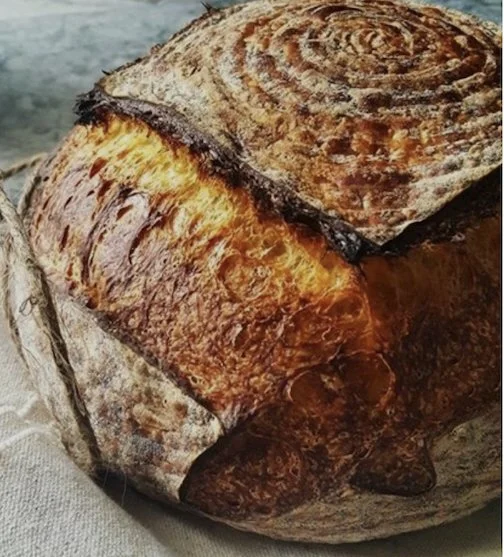SOURDOUGH
Sourdough Bread
The classic French sourdough bread is called Pain au Levain. The chewy dark brown crust contrasts with the tender interior and its mild tang that reminds you of Greek yogurt.
Sourdough is a type of bread made using a naturally fermented starter instead of commercial yeast. The starter is a mixture of flour and water that captures wild yeast and bacteria from the environment. The wild yeast causes the bread dough to rise, the bacteria gives characteristic flavor notes and tang to the sourdough bread.
Creating a sourdough starter takes about 7 days, but the amount of hands-on work each day is minimal.
Day 1: Blend flour and water together in a clean container. Cover loosely anklet sit at room temperature.
Days 2-7: Each day, discard half the starter and feed it with equal parts fresh flour and water. It will become bubbly and have a pleasantly sour aroma, indicating it’s ready for use.
Feeding schedule: Once your starter is established, keep it in the refrigerator. Feed it twice a week to maintain its activity level, using the discard half and replenish with fresh flour and water routine you’ve been using.
It easiest to begin use the equal weights flour and water when you are first learning to bake sourdough breads. It’s easy: If your starter weighs 100 g, then you need to feed it 100 g fresh water and 100 g fresh flour.
Feeding ratios can vary, however. Adding more flour or more water changes the texture of your starter. This affects the fermentation rate. This alters the flavor nuances. You can experiment with different hydration ratios (water to flour) and experience the subtext changes for yourself. That’s one of the most exciting parts about baking sourdoughs. In “Modern Breads/Wild Yeast”, there’s a whole section of how too do this and what types of flavors and aroma you can achieve.
Most starters begin with all-purpose or bread flour. But any type of flour can be used to start your sourdough starter—all flour has starch, and that’s the food for the wild yeast. Once you have established your starter, it’s better to use the same flour you’ll be using for making your sourdough breads. A good quality, unbleached all-purpose flour works well for most sourdough breads. If you prefer a chewier bread and want to ferment your doughs longer to make them more sour, an unbleached bread flour works best.
Many bakers like to keep more than one starter. To create a whole wheat starter, for example, simply take the discarded starter and feed it with fresh whole wheat flour and water. Repeat this for 2 more days and you’ll have an earthy, nutty starter perfect for making heartier sourdough breads.
The Pain au Levain (“Bread made from a natural yeast starter”) is a centuries-old French classic. There’s an extra step in this process called making a Levain, or leavener from the starter prior to making your main sourdough bread. This step involves feeding some of the starter an additional feeding of fresh flour and water to increase the yeast activity, boost the flavor compounds from the bacteria, and make the dough rising more reliable.
“Modern Breads/Wild Yeast” gives a deep dive on how the Pain au Levain process works.
